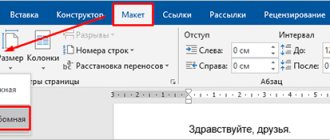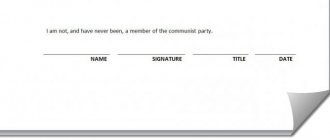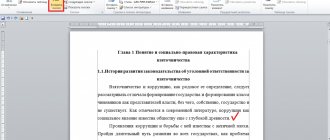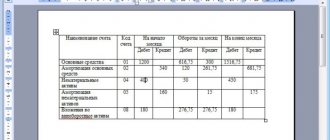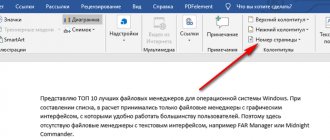Change table of contents options in a Word document
In Microsoft Word, when creating a table of contents for a document, built-in or independently created heading styles are used as a basis.
If the source document does not have headings, then you will need to create them first so that you can use the auto-assembled table of contents in Word when designing.
Follow these steps:
- Open a Word document.
- Select the text that will be used as the title.
- In the “Home” tab, from the “Styles” area, set a suitable style for the header.
Apply the selected styles to format all headings in this document.
By default, Microsoft Word has three levels of nesting available for headings: “Heading 1”, “Heading 2”, “Heading 3”. Typically, the “Heading 1” style is used in the title of the document, “Heading 2” is used for subheadings in the text, and in files with a more complex hierarchy, the subheading “Heading 3” is indispensable.
You can change the style settings yourself:
- Click the arrow in the lower right corner in the Styles area.
- In the “Styles” window, click on the “Manage Styles” button.
- In the Manage Styles window, change the settings of the selected style or create a new style.
If necessary, you can add styles to the document for headings of greater nesting:
- In the “Links” tab, click on the “Table of Contents” button.
- From the context menu, select “Custom Table of Contents...”.
- In the “Table of Contents” window, in the “Table of Contents” tab, in the “General” section, in the “Levels” field, enter the number appropriate for the heading level.
- Click on the "OK" button.
If necessary, select a higher level of nesting for the headings used in this document: "Heading 4", "Heading 5", etc. See how the new headings for this document appear in the Print Sample Document or Web Sample Document windows "
Many people are interested in the answer to the question of how to automatically add page numbers to the content. If you need to indicate page numbers in the table of contents of the document, then you need to activate the “Show page numbers” item (this option is enabled by default). Accordingly, if you do not need content numbering in this particular document, uncheck this option in Word.
Set numbers to be displayed to the right. This option is enabled by default.
In the Filler field, select a padding style (dots, dashes, solid line) between the title title and page number. Choose an option or turn off this option to remove periods from the table of contents in your Word document.
Interesting life hack
Let's assume that you are faced with the following task: divide the finished text into sections, outline its structure and make a table of contents. All this can be done in one section of Word settings - “Table of Contents”. That is, you don't have to use "Styles" to indicate subheadings.
You simply read the text, and along the way in the “Add text” section you indicate what to do with a specific piece: not include it in the table of contents, that is, mark it as text, designate it as a first, second or third level heading.
Please note: the interface may differ in different versions of Microsoft Office, but the location of the tabs, options, and the essence of working with the table of contents does not change. All instructions given in this article remain valid.
The specific design of the table of contents does not change, even if you are working on a tablet, phone or other device.
Useful life hacks: How to check a text for uniqueness, How to learn copywriting, Place punctuation marks online automatically in the text
How to make a table of contents (table of contents) in Word manually
It may well happen that the document does not have headings formatted in certain styles. In this case, you need to add a table of contents to the Word document page yourself.
Follow these steps:
- In an open Word document window, open the Links menu.
- Place the mouse cursor in the appropriate place to insert the table of contents.
- In the "Table of Contents" group, click the "Table of Contents" button.
- In the “Built-in” menu that opens, select “Manual table of contents”.
- A table of contents area will appear at the point where your mouse pointer is in the open Word file, where you must manually add document headings.
The disadvantage of this method is that if the document section names change, you will have to apply those changes manually. If you change or add text content, and because of this the page numbering may change, you will need to change the page numbers in the table of contents yourself.
Taking into account the above, it is better to use the simplest option: create content in Word automatically with page numbers and a suitable heading style.
Common mistakes when designing content
The following mistakes made when compiling the table of contents may result in a lower grade for a scientific paper. Check them out to prevent this from happening in your project.
- Violation of the order of placement of chapters, subsections and paragraphs in the contents and main text of the work. It is also considered a gross mistake to mention in the table of contents a section that is not in the text of the study.
- Spelling and punctuation errors. There should be no grammatical defects in any structural element of the course project.
- Low originality of section and subsection names. You need to come up with them yourself, based on the topic of the work, and not take ready-made ones from the Internet.
If you have any difficulties, you can independently prepare the content of the coursework using our article.
Automatic table of contents in Word: an easy way
Take advantage of the application's built-in features to quickly create an automatic table of contents for your Word document. Headings must be highlighted in the source text in advance, according to the hierarchical structure of the document.
Follow these steps:
- In the Word document window, open the Links tab.
- Place your mouse pointer where you want to insert the table of contents.
- Click on the “Table of Contents” button, which is located in the “Table of Contents” group.
- In the menu that opens, select from the list one of the styles of automatically collected tables of contents that fit the parameters, for example, the “Auto-collected table of contents 1” style.
- A table of contents area will appear at the location of the mouse cursor with all the headings and page numbers that are in this document.
As a result of this operation, an automatic table of contents was created in Word in our document.
By default, each heading has a filler (dotted space) and a page number. You can change these settings using the Custom Table of Contents feature.
If you press the “Ctrl” key and then click the cursor on the title of a document chapter from the header, you will automatically navigate to the place where the corresponding section of the document is located.
On a note
- You don't have to wait until your document is completely finished to insert a table of contents. Conversely, if you're creating a long document, you can add a table of contents right away so you can navigate through the document as you work on it.
- Not all documents require a table of contents; it is clearly not needed for letters and notes and would be obviously overkill for small documents.
- The table of contents looks natural in official reports and documents longer than 10 pages. Any document that deserves a title page may well also have a table of contents, built-in navigation for the people who will use it.
How to make a table of contents a separate page in Word
When preparing a document, you may need a separate page on which the table of contents will be placed in Word. To implement this feature, use the page break function.
You need to do the following:
- Place your mouse pointer in front of the table of contents.
- Press the “Ctrl” + “Enter” keys.
- Click after the table of contents area.
- Again you need to press the “Ctrl” + “Enter” keys.
Selecting additional parameters for the document table of contents
For some users, automatic changes to table of contents settings are not enough. In this case, it is possible to adjust the settings of additional table of contents parameters.
You will need to do the following:
- Open the “Links” tab in the Word document window.
- Go to the “Table of Contents” group, and then click on the “Table of Contents” button.
- In the menu that opens, click on “Custom Table of Contents”.
- The Table of Contents tab opens in the Table of Contents window.
- To change some settings, click on the “Options...” button.
- The Table of Contents Options window has options related to text style settings, structure levels, and table of contents item fields.
- In the "Table of Contents" tab, click on the "Edit..." button to open a tool with style selection settings for each heading level.
- If you click on the “Edit…” button, you will have access to additional options that apply to this heading: style, formatting, font, indents, spacing, etc.
- Don't forget to click on the "OK" button to apply the settings.
You may also be interested in:
- How to remove a blank page in Word - 6 ways
- How to turn a page in Word
Benefits of auto table of contents
Without content in a large document such as an essay, term paper, financial report or book, it is difficult to find the information you need. Making a list of paragraphs manually is time-consuming and ineffective.
Now you may be thinking, why bother yourself with unnecessary functions if you can write everything by hand. Perhaps you consider this to be the whim of a teacher or boss.
More than 100 cool lessons, tests and exercises for brain development
Start developing
However, auto content has significant advantages:
- all important points will appear on the list themselves, we just need to highlight them as we write the document or after finishing the main work;
- sections and paragraphs are also hyperlinks; they will lead to the corresponding part of the text and provide navigation through it, which is especially important for lengthy works;
- neat, even stitches in the same style without any effort on our part; it’s quite difficult to align them manually, I tried.
When you learn how to create beautiful, user-friendly automatic tables of contents, you will feel the difference.
How to change a created table of contents
There are situations when, after creating a table of contents, you may need to make some adjustments to its style or formatting.
Do the following:
- In the open Word document window, click on the table of contents area.
- A panel will appear in the upper left corner of the table of contents area, where you should click on the “Table of Contents” button.
- From the open menu, choose a different formatting method for the content of this document.
Step-by-step instruction
Despite the simplicity of Microsoft Word, the capabilities of this program are extensive. Your text can become a beautifully designed finished work if you create a document with table of contents, hyperlinks, and numbering. It is enough to familiarize yourself with the basic settings and master the functionality. Numbering a multi-page document is not difficult if you know the algorithm of actions. This knowledge will not only make your work easier, but will also allow you to create more structured texts.
The process of creating content in Word consists of 3 stages:
- Highlighting subheadings.
- Setting up sheet numbering.
- Creating a table of contents.
Next, let's look at each of these steps in more detail.
How to remove a table of contents in Word
In some cases, the table of contents of a document becomes unnecessary, so it needs to be deleted. To delete content (table of contents) in Word, use one of the proposed methods.
1 way:
- Click on the table of contents area of the document.
- In the menu that appears, located in the upper left part of the table of contents area, click on the “Table of Contents” button.
- Select "Delete Table of Contents" from the drop-down menu.
Method 2:
- In the open Word document window, go to the “Links” tab.
- In the “Table of Contents” group, click on the “Table of Contents” button.
- In the open menu, select “Delete table of contents”.




